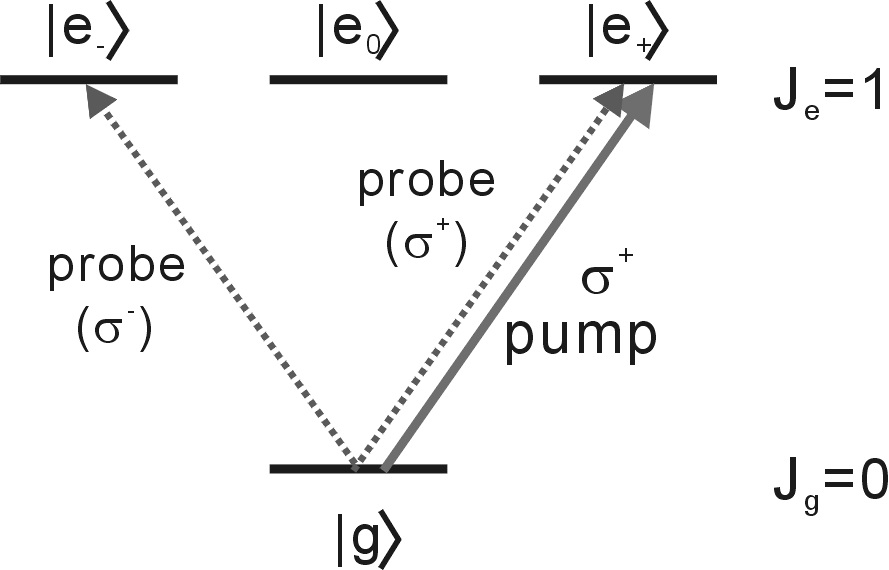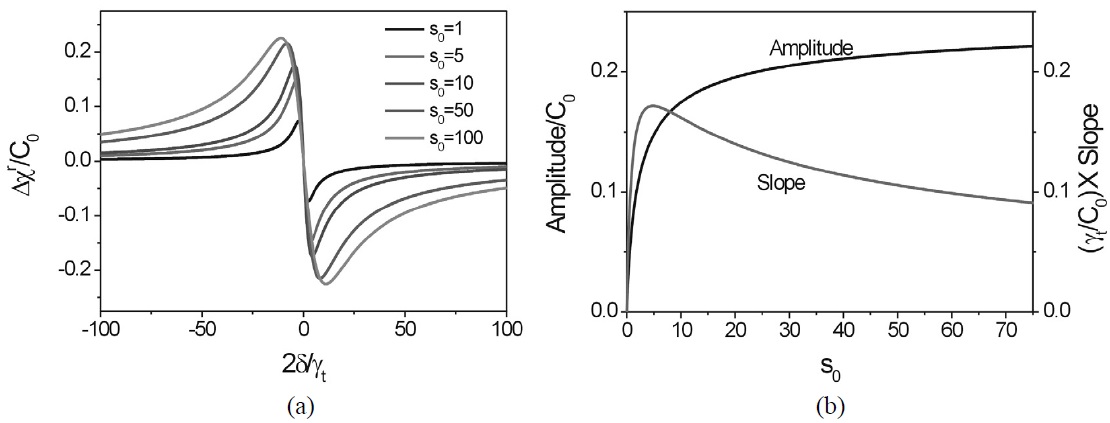Due to the ability to provide a dispersive spectroscopic lineshape, polarization spectroscopy (PS) [1] has been widely used and studied in particular for laser frequency stabilization. In PS, a circular birefringence is established by a circularly polarized pump beam. This is detected by measuring the rotation angle of a linearly polarized probe beam propagating in the opposite direction to the pump beam. The sub-Doppler feature originates from the fact that only the atoms belonging to certain velocity classes can experience the pump and probe beams simultaneously. The atoms with zero velocity contribute to the resonance signals, whereas the crossover signals result from the contribution from the atoms satisfying the condition that the frequency spacing of the excited state is equal to twice the Doppler shift.
PS has been realized for many kinds of atoms such as Li [2], Rb [3-6], Cs [6,7], K [8], He [9], and Sr [10]. In the case of all the atoms except for Sr, the PS spectra result from three operating mechanisms such as Zeeman and hyperfine optical pumping and the saturation effect. In contrast, the PS for Sr results from only the saturation effect because there are no degenerate sublevels in the ground state. Since the isotopes 84Sr, 86Sr, and 88Sr possess zero nuclear spin (I = 0), whereas 87Sr possesses I = 9/2, the Jg = 0 → Je = 1 transition exists in the isotopes 84Sr, 86Sr, and 88Sr. In this paper, we will consider 88Sr. In addition, Yb isotopes with mass numbers, 168, 170, 172, 174, and 176, also possess zero nuclear spin. Because the energy level structure of Sr (and Yb) is very simple, it is possible to obtain exact analytical solutions for the PS spectra. The analytical solution of saturated absorption spectroscopy (SAS) for the ideal two-level atoms was presented in the textbook [11]. Also, SAS [12] and PS [13] for Rb atoms were analytically studied in the low intensity limit. In this paper, we present analytical solutions of PS for the transition Jg=0→Je =1 of Sr (or Yb) atoms where the intensity of the pump beam is arbitrary. This paper is organized as follows. Section II describes the theory of calculating analytical lineshape in PS. Results and discussion are presented in Sec. III. The final section summarizes the results of the paper.
The energy level diagram for the transition Jg=0→Je =1 of an atom (88Sr or Yb) is shown in Fig. 1. The ground state is |g>, while three degenerate excited states are |e?>, |e0>, and |e+> where magnetic quantum numbers are -1, 0, and 1, respectively. The pump beam of σ+ polarization excites the transition from |g> to |e+>, whereas the linearly polarized probe beam excites both the transitions from |e> to |e±>. ω0 is the resonance frequency, λ is the wavelength, k = 2π/λ is the wave vector, Ω1(2) are the Rabi frequencies for the pump (probe) beam, Γ is the
decay rate of the excited state, and γt is the decay rate of the optical coherence which is equal to Г/2 if there is no dephasing mechanism. The laser frequencies of the pump and probe beams felt by an atom moving at velocity, v, are ω1 =ω + kv and ω2 =ω ? kv, respectively.
Then, the susceptibilities of the σ± components of the probe beam for an atom moving at velocity, v, are given by [14]
where p denotes the population of the ground state, q± denotes the populations of the excited states, |e±>, and Nat represents the atomic density. The populations in Eq. (1) are calculated analytically by considering the effect of only the pump beam. Since the σ+ polarized pump laser field couples only the ground state and the excited state (|e±>), we can use the results for the case of a two-level atom. Thus, we refer to our previous result [14] or a textbook [15], and the results are given by
and q0 = q? = 0, where A = (ω1 - ω0)2 +γt2 and B =Ω12γt/Γ.
Therefore, the susceptibilities in Eq. (1) become the following equations:
Equations (2) and (3) are then averaged over the Maxwell- Boltzmann velocity distribution a
where u is the most probable speed of the atom. Equation (4) is further simplified by changing the integration variable as
where
and δ(=ω ?ω0) is the detuning and s0(=Ω12/γtΓ)=I1/Is is the on-resonance saturation parameter where I1 is the pump beam intensity and Is = πhcΓ/(3λ3) is the saturation intensity with c being the speed of light in vacuum. The integration in Eq. (5) can be easily performed using a convolution theorem. When γt≪ku, the real and imaginary parts of the susceptibilities are given by
respectively.
In PS, a linearly polarized probe beam (intensity is I0 and polarization vector is
is incident on an atomic cell of length l along the z axis. After traversing the cell, the polarization of the probe beam changes due to the circular anisotropy from the pump beam. The electric field of the probe beam is then given by [5,14]
where E0 is the amplitude of the incident probe beam’s electric field, a± = e-(k/2)χi±l, and n± ? 1+(χ±/2) are the refractive indices of the σ± components of the probe beam.
are the spherical bases where
are the unit vectors for x and y axes, respectively. The inclination angle of the electric field in Eq. (6) with respect to the x axis is given by θ + ? where θ is the inclination angle of the incident probe beam’s polarization and ?=(kl/2)(n--n+) ? (kl/4)(χ-r-χ+r)is the rotation angle of the probe beam's polarization after traversing the atomic cell [16]. Then, the difference in the intensities along the x and y axes, ΔI = Ix ? Iy, is given by
ΔI = I0a+a_cos[2θ+2?],
and becomes further
ΔI = I0a+a_sin2?,
when θ =π/4. Since the rotation angle, ?, is very small, the PS signal is given by
where
is the average of the absorption coefficients. The difference in the real parts of the susceptibilities (Δχr ≡ χ?r?χ+r) is given by
where
We neglect e?δ2/(ku)2 in Eq. (8) because |δ| ≪ku.
The typical PS spectra (Δχr) for several pump beam intensities are presented in Fig. 2(a). In Fig. 2(a), the saturation parameters were s0 = 1, 5, 10, 50, and 100. The saturation parameter of s0 = 100 corresponds to the intensities of 4.27 W/cm2 because the saturation intensity of Sr atom is about 4.27×10-2 W/cm2. The amplitude of the spectrum, defined as |Δχr| at x=±1, and accordingly at the detunings of
is given by
and the magnitude of the slope of the PS spectrum at the resonance condition is given by
The calculated amplitude and slope as functions of s0 are presented in Fig. 2(b). In Fig. 2(b), the amplitude increases and is then saturated at the value of C0/4. In Fig. 2(b), the slope is maximum when
This value corresponds to the intensity of 0.206 W/cm2. This is in excellent agreement with the experimental results in Fig. 4(b) in Ref. [10].
In this paper we have presented a theoretical study of lineshape in PS for the transition Jg=0→Je =1 of Sr atoms. Equations (7) and (8) are the main result of the paper. The amplitude and the slope of the spectrum are presented in Eq. (9) and Eq. (10), respectively. The theoretical results were compared with experimental results presented in Ref. [10], and excellent agreement between them was found. Since the obtained results in this paper are very concise, these can be applied to study of PS for other atoms such as Yb and to study of other spectroscopy such as sub-Doppler dichroic atomic vapor laser lock (DAVLL) [10].





